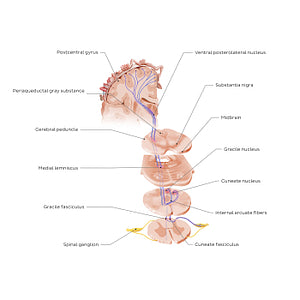Paul Kim
Posterior column-medial lemniscus pathway (PCML) (English)
Posterior column-medial lemniscus pathway (PCML) (English)
There are three groups of neurons involved in the posterior column-medial lemniscus pathway (PCML): first-order, second-order, and third-order neurons. The cell bodies of first-order neurons are located in the spinal/dorsal root ganglion, which receive the sensory information from the periphery and send their afferent fibers through the posterior root of the spinal nerve into the posterior horn of the spinal cord. The fibers leave the posterior horn without synapsing and enter the posterior funiculus of the spinal cord, where they form either the gracile or cuneate fasciculus. The gracile fasciculus carries sensory information from the lower extremities, while the cuneate fasciculus carries the information from the upper extremities. The gracile and cuneate fasciculi terminate in the caudal medulla oblongata by synapsing with the second-order neurons found in the gracile and cuneate nuclei, respectively. The second-order neurons project their axons, called the internal arcuate fibers, that cross the midline of the midbrain to the contralateral side. This represents the point of decussation of the PCML pathway, after which the medial lemniscus is formed. The medial lemniscus continues towards the thalamus, where it synapses with third-order neurons found in the ventral posterolateral nucleus. Fibers from these project through the posterior limb of the internal capsule to reach the primary somatosensory cortex in the postcentral gyrus of the parietal lobe. Here, sensation discrimitation is 'mapped' using a somatotopic arrangement, represented as the sensory homunculus.
Regular price
$7.56 USD
Regular price
Sale price
$7.56 USD
Unit price
per
Couldn't load pickup availability


#E0BA36
#A46655
#622427
#716A6A
#F7E09B
#D2B2AC

